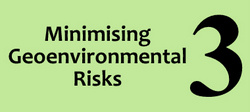Transforming the Mining Value Chain
Theme 3- Minimising Geoenvironmental Risks
 For environmental assessment of mining, it is important to focus on the characterisation of mine waste and prediction of mineral and element behaviour in the environment early in the life-of-mine cycle. Thus, rapid and reliable analyses of drill core samples need to be completed to gain early insights in likely environmental management issues at mine sites. The environmental impact of wastes and ores is strongly affected by their mineralogy and trace element compositions. Most methods needed in the environmental area are similar to those used to determine the deportment of elements in the geometallurgical field. However, trace element concentrations are lower and the priority to keep analysis cost low is even more stringent.
For environmental assessment of mining, it is important to focus on the characterisation of mine waste and prediction of mineral and element behaviour in the environment early in the life-of-mine cycle. Thus, rapid and reliable analyses of drill core samples need to be completed to gain early insights in likely environmental management issues at mine sites. The environmental impact of wastes and ores is strongly affected by their mineralogy and trace element compositions. Most methods needed in the environmental area are similar to those used to determine the deportment of elements in the geometallurgical field. However, trace element concentrations are lower and the priority to keep analysis cost low is even more stringent.
Environmental prediction also requires an understanding of the deportment of environmentally sensitive elements. For example, U occurs as a major component in uraninite, coffinite and carnotite, as a minor component in apatite, zircon, hematite, allanite, monazite, REE phosphates and as a trace component in feldspar. Mapping deleterious elements will take the same approach as penalty elements as described for Theme 2.
The objective is to automate mapping and interpretation of mineralogy, mineral chemistry and textural features of ores and altered rocks in order to develop new geochemical and computational tools to predict the environmental impact of mining and waste.
Theme 3 will produce the following outcomes:
i) Standardised LA-ICPMS / QEMSCAN / MLA / Corescan protocols and computerised data processing tools for waste characterisation;
ii) Proxies connecting the detailed coreshed and laboratory-based characterisation to cheaper and more rapid bulk characterisation techniques.
